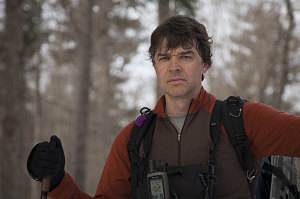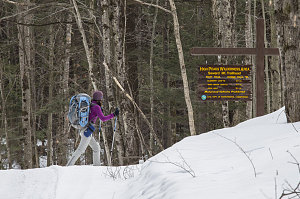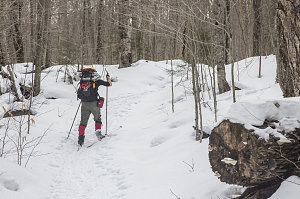Seymour is not super-high on my list of desirable repeat climbs in the Adirondacks. But, today was special. Good friend Harold Piel was finishing the last of his Winter 46, and the least I (and a few other friends) could do was to join him on this memorable occasion.
For those of you who do not know, the "Adirondack 46" is the term coined to define all 46 peaks in the Adirondack Mountains over 4000 feet. Associated with this set of peaks is the the Forty-sixers organization - an organization still going strong after a hundred years. Those who have climbed all of the peaks can apply for membership and be designated "46Rs". Within this club, however, is a special sub-designation: W46R. The W stands for winter, and to become a member of this exclusive group, you must climb all of the Adirondack 46 in winter - between December 21 and March 21. After becoming a "regular" 46R
back in 2010, Harold had been working hard on climbing all of the 46 in winter. Today was his last remaining winter peak: Seymour Mountain, on the far western edge of the Adirondack High Peaks.

Winter Trailhead
I was keen to join Harold on his big day; but I wasn't so keen on the trip in to Seymour. While the mountain does have a few nice overlooks at its summit, there is a long and fairly boring approach to get to its base. And worse, in winter there is an extra 3 miles each way that one must cover on foot. This is due to a private access road that gets barricaded during the winter months. The total length of the journey in winter, therefore, is nearly 20 miles (32km). Tedious!

Ampersand Road
In total our group counted five: myself, Jenn, Roland, Brian and Harold. Brian and Harold chose to spend the night before in a local motel; Jenn, Roland and I chose to drive in early in the morning.
In order to speed things up a bit, I thought that perhaps we could do much of the approach on cross-country skiis. The elevation profile of the approach to Seymour Mountain's base is fairly flat - lending itself well to ski travel.
Harold and Brian declined the ski option, but Jenn and Roland and myself decided to go for it. Since this was entirely a there-and-back sort of affair, we could always decide to ditch the skiis and switch to snowshoes at any point in time.
The "winter" trailhead for Seymour and the Seward Range in general is located at the end of Corey's Road, where a gate (closed during winter) separates it from the start of Ampersand Road. Thinking that we'd be able to catch up with Brian and Harold on our skiis, we arrived about 40 minutes behind them. After a few minutes of setup, we were off, about an hour after they had started.
Even though Ampersand road is closed to public traffic, it was clear that it was being used [by vehicles]. The area just to the north of the Sewards is private land, with residences and logging, and perhaps there was logging truck traffic during the week days, requiring the road to be cleared.
As a result of the plowing, the road was not ideal for skiing. Instead of a nice powdery trail, we had a hard-packed surface. Fortunately a few inches of recent snow had made it just barely acceptable for skiing. And, there was enough of a base to cover any rocks or gravel along the road.

courtesy RHanel

courtesy RHanel
It took us nearly one hour to cover the nearly 3-mile stretch from the gate to the summer trailhead. This wasn't a great time as cross-country skiing goes, but it was about 20-30% faster than if we had been walking. We checked the trailhead register to discover that Brian and Harold had passed this point about forty minutes before, meaning we had chopped off twenty minutes of the one hour lead that they had on us. We were catching up, but only slowly.

Arriving, summer trailhead
Beyond the summer trailhead, we were no longer on a plowed road, but on trail proper. This was both good and bad; good because we now had a nice base of snow upon which to ski. But, as we were to discover, there was a downside: that base was not quite thick enough for an optimal ski experience.

Trail to the Sewards
Most hiking trails - even ones like this relatively flat one - has its share of little irregularities: stones, boulders, fallen branches, little stream crossings. On foot, these are inconsequential. However, on skiis, each one of these is a little obstacle that must be negotiated. Now, when there is a thick enough base of snow, all of this is covered and the going is easy. We discovered, however, that while there was enough snow to cover everything, it wasn't enough to completely flatten out all of these irregularities. As a result, we were constantly maneuvering around, trying to avoid a spill or breaking our skiis on a sharp dip or obstacle. A surprising amount of effort was required to do this (one side note here: we were using nordic cross-country skiis - thin, long and not really designed for this sort of thing. A true backcountry ski would probably have made this a lot easier).
Junction to Calkins Brook
Although we contemplated it several times, the difficulty never quite got to the point where the equation tipped in favor of switching to snowshoes. Despite the difficulties, we could tell we were making a better average speed than if we were on foot; and in any case, we wanted to catch up with Brian and Harold.
We arrived at the Blueberry Lean-to (shelter) at 10:20 a.m. Still no Brian and Harold. After a quick break, we continued. Soon, conditions for skiing improved: we intersected with an old decommissioned road, providing a much-welcomed even grade. This we sped along at increased speed to the Ward Brook Lean-to, which we reached only twenty minutes later. Along the way, we met a fellow hiker coming the other way, who informed us that we were still about twenty minutes behind Brian and Harold. Wow - they were moving pretty fast!
At the Ward Brook shelter, we took a longer break. We were near the start of the base of the Seymour Mountain herdpath, and skiing was no longer possible. It was time to switch to our snowshoes. Also, Roland was having toe problems and needed some time to effect repairs.
Once fixed up on showshoes and refreshed with a bit of food, we continued on. In a hundred yards or so, we turned off of the old road and onto the Seymour Mountain herdpath route. This isn't an official trail, but has been well-established by hikers. A well-defined set of snowshoe tracks led off into the woods towards the peak.
